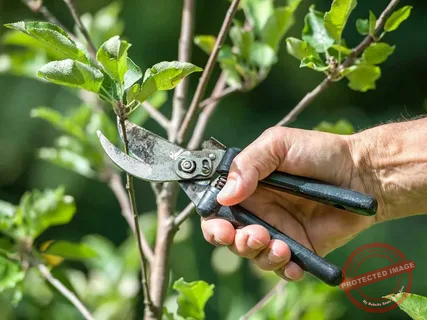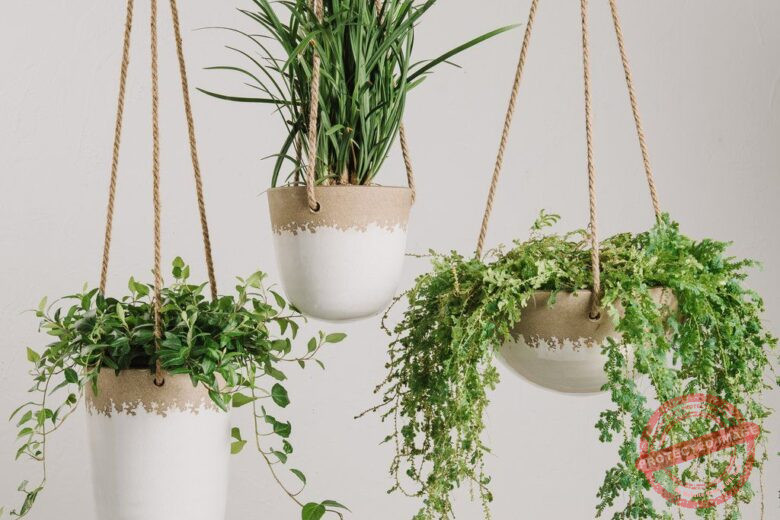Vertical gardening has gained significant popularity in recent years due to its space-saving capabilities and aesthetic appeal. Among the many vegetables you can grow in a vertical garden, lettuce stands out as a versatile and rewarding option.
To grow lettuce in a vertical garden, choose a sunny location and install a sturdy vertical garden structure, select lettuce varieties, plant seeds or seedlings in well-draining soil, water consistently, maintain air circulation, watch for pests, and harvest when ready. Consider companion planting, mulching, and researching for success.
In this comprehensive guide, we’ll walk you through the step-by-step process of growing lettuce in a vertical garden, catering especially to beginners who are looking to embark on this green journey.
How to grow lettuce in a Vertical Garden step-by-step guide

Step 1: Understanding Vertical Gardening
Before you dive into the practical aspects, it’s crucial to grasp the concept of vertical gardening. Essentially, vertical gardening involves growing plants in a vertical orientation, often against walls, trellises, or hanging structures. This technique is particularly suitable for those with limited space, as it allows you to utilize the vertical dimension and create a lush garden in a small area.
Read Also: 25 Easiest Vegetables to Grow from Seed
Step 2: Choosing the Right Lettuce Varieties
As a beginner, selecting the right lettuce varieties is essential. Opt for varieties that are well-suited for vertical growth and don’t require excessive space. Romaine, Butterhead, and Looseleaf lettuce are excellent options, as they tend to grow upwards and have a compact habit.
Step 3: Planning Your Vertical Garden
Planning is the foundation of a successful vertical garden. Consider where you’ll set up your garden – it could be against a sunny wall, on a balcony, or even indoors near a sunny window. Ensure that the chosen location receives adequate sunlight, as lettuce plants thrive in sunlight-rich environments.
Read Also: 25 Easiest Vegetables to Grow in Pots
Step 4: Gathering Your Tools and Materials
Before you start, gather all the necessary tools and materials:
Containers: Choose containers that are suitable for your vertical structure. These containers should have good drainage to prevent waterlogging.
Potting Mix: Invest in a high-quality potting mix that offers proper drainage and nutrients for your lettuce plants.
Lettuce Seeds: Purchase lettuce seeds of the varieties you’ve chosen.
Vertical Garden Structure: Depending on your available space, select a suitable structure, such as a trellis, hanging pouches, or stacked containers.
Watering Can: You’ll need a watering can for regular irrigation.
Gardening Gloves: Protect your hands with gardening gloves while working with soil and plants.
Read Also: Avocado Seed Growing Stages [A Comprehensive Guide]
Step 5: Preparing the Vertical Garden Structure
Proper preparation of your vertical garden structure is vital to ensure its stability and effectiveness. Carefully follow the manufacturer’s instructions to assemble the structure securely. This step is essential to support the weight of your growing lettuce plants.
Step 6: Filling Containers with Potting Mix
Fill the containers with the chosen potting mix, leaving some space at the top for watering. The potting mix should be well-draining and rich in nutrients to provide optimal conditions for your lettuce plants to flourish.
Read Also: 25 Easiest Vegetables To Grow Indoors
Step 7: Sowing Lettuce Seeds
Sowing lettuce seeds is where the excitement truly begins. Make small holes in the potting mix, following the instructions on the seed packet. Gently place the seeds in the holes and cover them lightly with soil. Be sure to keep a reasonable distance between the seeds to allow room for growth.
Step 8: Watering Gently
After sowing the seeds, use a watering can to moisten the soil gently. Avoid using a strong stream of water, as it could displace the seeds. The goal is to provide even moisture to help the seeds germinate.
Read Also: [Complete Guide] 50 Gardening Tips For Beginners
Step 9: Providing Sunlight
Lettuce plants require ample sunlight to thrive. Position your vertical garden in an area that receives at least 6 hours of sunlight per day. If you’re growing indoors, place your garden near a sunny window or consider using artificial grow lights to supplement natural light.
Step 10: Maintaining Proper Watering
Consistent and appropriate watering is essential for healthy lettuce growth. Check the moisture level of the soil regularly, and water when the top inch feels slightly dry to the touch. Avoid overwatering, as it can lead to root rot.
Read Also: How Fast Do Cucumbers Grow? 10 Tips to Accelerate Growth
Step 11: Fertilizing Your Lettuce
As your lettuce plants develop, they’ll require nutrients for optimal growth. Choose a balanced liquid fertilizer and apply it every few weeks according to the package instructions. This will help ensure that your plants have access to the essential nutrients they need.
Step 12: Monitoring for Pests and Diseases
Vigilance is key when it comes to identifying and addressing potential pest or disease issues. Regularly inspect your lettuce plants for signs of pests like aphids or snails. If you notice any problems, explore organic pest control methods, such as introducing beneficial insects or using neem oil.
Step 13: Harvesting Your Lettuce
As your lettuce plants mature, you’ll be rewarded with the opportunity to harvest your homegrown produce. Start by gently picking the outer leaves when they reach an edible size. This “cut and come again” approach allows the inner leaves to continue growing, providing you with a continuous supply of fresh lettuce.
Read Also: [Beginners Guide] How To Grow Avocado At Home
Step 14: Experimenting with Recipes
Once you’ve harvested your lettuce, it’s time to enjoy the fruits of your labor. Experiment with various recipes that incorporate your homegrown lettuce. Create salads, wraps, sandwiches, and more, and relish the satisfaction of eating what you’ve grown.
Step 15: Learning and Improving
Gardening is a journey of continuous learning. Take note of what works well and what could be improved. As a beginner, don’t be discouraged by any challenges you encounter. Embrace each experience as an opportunity to enhance your gardening skills and knowledge.
Read Also: [Pdf Sample] Fruit And Vegetable Business Plan Docx
By following these steps, you’re well on your way to becoming a successful vertical lettuce gardener. Remember that every gardener starts as a beginner, and with practice and dedication, you’ll develop the expertise to create thriving vertical gardens that yield delicious, homegrown lettuce.
15 DIY vertical lettuce garden idea
Vertical gardening has revolutionized how we grow plants, especially in urban and space-constrained environments. If you’re a lettuce lover and want to embark on a unique gardening journey, consider creating your own DIY vertical lettuce garden. In this article, we’ll explore 15 creative ideas to inspire your vertical lettuce gardening project.
1. Pallet Planter
Transform a wooden pallet into a vertical planter by attaching pockets made from burlap or landscape fabric. Fill each pocket with potting mix and plant your lettuce seeds or seedlings. Lean the pallet against a wall or fence for an instant vertical garden.
2. Hanging Shoe Organizer
Repurpose an old hanging shoe organizer into a functional lettuce garden. Fill the shoe pockets with soil and lettuce plants, and hang the organizer in a sunny spot. This idea is perfect for small spaces like balconies or kitchens.
3. Stacked Terracotta Pots
Stack terracotta pots of varying sizes, securing them with a sturdy rod through the center. Fill each pot with potting mix and plant your lettuce. This tiered arrangement not only saves space but also creates an eye-catching display.
4. Gutter Garden
Mount gutters horizontally along a wall or fence. Fill the gutters with soil and plant lettuce along the length. This modern and space-efficient approach is not only functional but also visually appealing.
5. Hanging Basket Tower
Hang a series of hanging baskets from a vertical structure, such as a trellis or post. Fill the baskets with lettuce plants, creating a cascading tower of greens.
6. Pyramid Garden
Construct a pyramid-shaped frame using wood or metal. Attach planter boxes to each level and fill them with soil and lettuce. This architectural approach adds a unique element to your garden.
7. Vertical Pallet Garden with Irrigation
Enhance your pallet planter by adding a simple irrigation system. Attach small plastic bottles filled with water to the pallet, allowing a slow drip of water to keep your lettuce consistently hydrated.
8. Hanging Mason Jars
Suspend mason jars using twine or wire, creating a whimsical hanging garden. Plant lettuce in each jar and hang them near a sunny window or on a porch.
9. Trellis Lettuce Wall
Install a trellis against a wall and train your lettuce to grow vertically. This method not only conserves space but also provides an artistic touch to your garden.
10. Ladder Planter
Repurpose an old ladder into a vertical lettuce garden. Place planter boxes or containers on the ladder rungs and fill them with soil and lettuce.
11. Vertical Pallet Garden with Chalkboard
Combine functionality with aesthetics by attaching a chalkboard panel to your pallet planter. Use the chalkboard to label your lettuce varieties or jot down gardening notes.
12. Cinder Block Garden
Stack cinder blocks to create planting pockets. Fill the pockets with soil and lettuce plants. You can also utilize the open spaces in the cinder blocks for additional herbs or flowers.
13. Repurposed Shelves
Turn old wooden shelves into a vertical garden by attaching pots or containers to the shelves. Arrange the shelves against a wall or fence for an organized and space-saving lettuce garden.
14. PVC Pipe Tower
Cut PVC pipes into sections and stack them vertically. Plant lettuce in the openings of the pipes. This modern and minimalist approach adds an element of intrigue to your garden.
15. Lattice Lettuce Wall
Attach a lattice panel to a wall and let your lettuce vines climb. The lattice not only provides support but also adds a decorative element to your outdoor space.
How to Build a Vertical Lettuce Garden
To build a vertical lettuce garden, you can repurpose items like pallets, hanging shoe organizers, or trellises. Attach containers or pockets, fill them with soil, and plant lettuce seeds or seedlings. Ensure proper drainage and secure the structure. Place your vertical garden in a sunny spot and provide regular care to your lettuce plants.
How to Grow Lettuce in a Vertical Tower
Growing lettuce in a vertical tower involves stacking containers or pockets vertically. Fill each layer with soil, plant lettuce, and ensure adequate spacing. Place the tower in a sunny location and water regularly. As the lettuce grows, it will cascade down the tower, creating a visually appealing display.
Can You Grow Lettuce Vertically?
Yes, you can definitely grow lettuce vertically. Vertical gardening techniques, such as using trellises, hanging structures, or stacked containers, provide an innovative way to cultivate lettuce and save space.
How Much Vertical Space Does Lettuce Need?
Lettuce typically requires about 6 to 8 inches of vertical space to grow properly. However, compact lettuce varieties can thrive in even less space, making them ideal for vertical gardening setups.
How Do You Make a Lettuce Grow Tower?
To create a lettuce grow tower, stack containers or pockets vertically in a sturdy structure. Fill each layer with well-draining potting mix and plant lettuce. As the lettuce grows, it will spill over the edges, creating a cascading effect. Ensure the tower is stable and receives adequate sunlight.
How Long Does It Take to Grow Lettuce in a Tower Garden?
Lettuce grown in a tower garden typically takes around 30 to 60 days to reach maturity, depending on the variety. Looseleaf lettuce varieties tend to mature faster than Romaine or Butterhead types.
How Do You Water a Lettuce Tower?
Watering a lettuce tower involves making sure each layer receives enough moisture. Water the top layer, allowing excess water to trickle down and reach the lower layers. Monitor the moisture levels regularly and adjust your watering frequency based on weather conditions.
Lettuce Wall Garden
A lettuce wall garden involves attaching a trellis or lattice to a wall and training lettuce plants to grow vertically. This creates a living wall of fresh greens that’s both decorative and functional.
Lettuce Grow Hydroponic Vertical Garden
A hydroponic vertical garden uses a soilless growing medium and nutrient-rich water to cultivate lettuce. The plants are suspended in a vertical arrangement, and the hydroponic system delivers water and nutrients directly to the roots, promoting efficient growth.
Growing Lettuce in PVC Pipe
Growing lettuce in PVC pipes is a creative approach. Cut PVC pipes into sections, drill holes for planting, and fill the pipes with soil. Plant lettuce in the holes, and the pipes can be vertically arranged to create a unique gardening display.
Can I grow lettuce indoors in a vertical garden?
Absolutely! Indoor vertical gardening is a fantastic option for growing lettuce, especially in areas with limited outdoor space.
How often should I water my vertical lettuce garden?
Check the moisture level of the soil daily and water when the top inch feels dry. The frequency may vary based on climate and weather conditions.
What’s the best way to prevent pests from damaging my lettuce?
You can introduce natural predators like ladybugs or use organic insecticides. Regularly inspect your plants for signs of pests and take action promptly.
Can I reuse the potting mix for my vertical garden?
It’s a good idea to replace the potting mix every growing season to ensure your plants receive adequate nutrients.
How can I ensure my vertical garden structure is secure?
Follow the manufacturer’s assembly instructions carefully and make sure the structure is anchored securely to prevent accidents.
Conclusion
In conclusion, growing lettuce in a vertical garden offers a rewarding and efficient way to enjoy fresh produce even in limited spaces. By thoroughly understanding each step and implementing the tips provided, you’ll be nurturing your lettuce plants with confidence and enthusiasm. Happy gardening!




One Reply to “[Beginners Guide] How To Grow Lettuce In Vertical Garden”